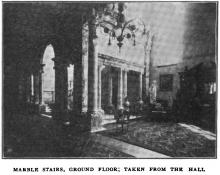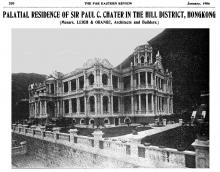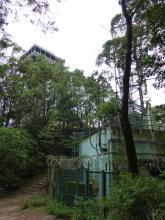Marble Hall / Admiralty House [1904-1953]
Primary tabs
Submitted by David on Tue, 2009-11-24 10:14
Current condition:
Demolished / No longer exists
Date Place completed:
1904-01-01
Date Place demolished:
1953-01-01
Built as Sir Paul Chater's residence. Later it became the residence of the Naval Commander-in-Chief of the China Squadron, and was known as "Admiralty House".
It was damaged by fire in the 1940s, shortly after the end of the war. "It apparently stood derelict until demolition commenced in November 1953 and a block of government flats was erected."
There's a good photo of Marble Hall, and lots more information about the Chater family, here. And more information about the Marble Hall building here.





Comments
Re: Marble Hall
Marble Hall was built in 1869.
Source: http://www.spc.edu.hk/upload_files/na/185_assembly0129.pdf
1910s Marble Hall Grounds overlooking the Campanile on Robinson Rd
I wondered about that
Chater was born in 1846, in 1869 he would have been 25, and just setting up his business, probably not ready to build a mansion.
on another site I see this "Marble Hall, built in 1890s, was once the residence of Hong Kong's first property tycoon – Paul Chater. ....."
In the Wikipedia entry for Leigh & Orange, "Leigh & Orange Ltd, founded in Hong Kong in 1874........
One of the more eclectic buildings designed by the firm was the Ohel Leah Synagogue in Robinson Road in 1901. It heralded a period of interesting projects including Marble Hall, the residence of Sir Paul Chater on Conduit Road, a building eventually donated to the government, later to become the colony’s Admiral House."
The building does not appear in an Underwood & Underwood stereopicture copyright 1901, (on the Library of Congress site)
but it does appear in a picture from the harbour showing Queens and Princes Buildings, but the buildings to the left have not been finished. c.1902-06, (on Flickr - user= Mayor McCheese)
my gut feeling is that 1896 is possible, but probably after 1900.
Re Marble Hall Completion Date
Yes, I think you are right about 1869 being incorrect. As you say, it may be 1896 or later. Will have another look through. Cheers.
Re: Marble Hall Completion Date
I was reading about Sir Paul Chater's life in the Hong Kong Telegraph.
Dated 27 May 1926, the day after he passed away.
"He purchased a large tract of land in what is now Caine Road and built a house for himself. He occupied this from 1869 until 1905 when, owing to the house being surrounded by tenements, he moved elsewhere.
When he first bought the land, it was merely a green hillside and now it is packed with dwelling houses."
From the Hong Kong Daily Press dated 28 May 1926
"Sir Paul built this palatial residence (Marble Hall) for himself above Conduit Road some fifteen years ago ."
This may point to 1911 or thereabouts being the year of completion.
Update to Marble Hall
Thanks to pointers from Marlowe, I made a trip to the PRO to try and unearth the completion date of Marble Hall.
From the Hong Kong Telegraph
Dated Dec 22, 1904 - there is a long account of Marble Hall and its construction, interior finishings, Greek marbling (not Italian as some websites have indicated) etc. As mentioned previously, the architects were Leigh & Orange and work had commenced 3 years ago (1901?) and was expectd to finish in March next year (1905?).
This timeframe fits in with Post Impressions photos from the SCMP taken from the same era that can be seen on Flickr:
http://www.flickr.com/photos/18561378@N02/2183617755/in/set-72157603052220693/
http://www.flickr.com/photos/18561378@N02/2220607408/in/set-72157603052220693/
re: Update to Marble Hall
Good work tracking that down. I've set the start date to c.1904, assuming the building will be visible in photos from around that time.
marble hall
this shot by hedda morrison from 1946/47 shows the missing and damaged rooftop of marble hall -presumably from the fire?
http://via.lib.harvard.edu:80/via/deliver/deepLinkItem?recordId=olvwork348264&componentId=FHCL:1081057
also it looks they've demolished the buildings in the hills above the botanical gardens - which are very lacking in trees because of the wartime need for fuel. the archway at the entrance commemorating the chinese contribution to the war stands out
Re: Admiralty House (Marble Hall)
Admiralty House was seriously damaged by fire on 11 May 1946.
Marble Hall
Hi all, I have just stumbled upon your website and blog about Marble Hall. I can probably answer all your questions as I am a distant family member of Sir Catchick Paul Chater and have researched all his own personal properties, including Marble Hall, but a biography I am writing about him.
The plot was purchased by him in October 1899. He got his friend James Orange, of Leigh and Orange to draw up plans and he started building in 1901. It totalled 59,100 sq. ft. but he added more land to it as surrounding plots became available. By 1903 it was almost complete and he had further enhanced the footprint to 62,678 sq ft. He had moved in by 1904 and was entertaining there and his priceless china collection and art work - The Chater Collection - was displayed there. In 1921 he started some major renovation and modification work adding onto one side of the house.
Inside, it was exactly as described. It's entrance was completely marble sourced fom Italy, it was of a beautiful thick green vein marble that you rarely see these days. I have photos which show the marble staircase - magnificent even by stately home standards here in the UK.
When he died he stipulated that the house and the collection should go to the government. It is my belief that he thought the government would eventually turn the house into a museum. He also stipulated that Lady Chater should continue to live there for as long as she wished. She did and died there in 1935. That is when it was handed to the government. You are right, in 1946 after the war and its occupation by Japanese officers, it was returned to the admiralty, and tragically it caught fire, an electrical fault. It stood derlict til the 1950s by which time anything of value, such as the marble had been stripped and it was but a shell. Now the plot holds government flats called Chater Hall.
Hope this has helped with your interest in Marble Hall. Please feel free to ask any questions. By the way, the link that someone posted to show the derelict building is no longer active, so unfortunately I couldn't see to confirm if it was Marble Hall or not.
best wishes
Liz
re: Marble Hall
Dear Liz,
Thanks very much for answering our questions - it's clear you've done a lot of research on the subject.
I just tried the link to the 1946 photo and it worked ok, so it may just have been a temporary problem.
Please let us know once the biography is published,
Regards, David
Hi David, Thanks for your
Hi David,
Thanks for your reply. I've been actively researching Sir Paul and his life - both personal and professional - for nearly 10 years now. I have HUGE amount of information on him but for reasons too numerous to explain here, I am unable to secure a major sponsor to get the biography of him finished. I have approached all the major companies in HK that he started (that's almost every one of them!), but in the commerical world other things take priority, which is understandable, but frustrating. So until I can get any kind of sponsor to help further I'm at a standstill so there is no definite time (if ever to be honest) when the biography will be published.
In the meantime, and since you're interested in his house Marble Hall, did you know that he had a a"weekend" bungalow in Kowloon? It was called Chater's Bungalow, I have pics of that too, it was seriously magnificent. His dining room EASILY accommodated 150 people when the King of Hawaii was visiting HK and Paul Chater had him over for lunch. In his grounds he had a tennis court, and I have a lovely photo of members of the Chater/Jordan family sitting on the stones steps that led down to the court all dressed in their finery holding their tennis racquets. Later on (when he moved into Marble Hall) he rented it out and the tennis courts became a golf course. The bungalow was adjacent to St. Andrew's church (which he built/paid for) and he gave some of his land from the bungalow to build the vicarage next door. Amazingly, the vicarage and church still stand. Everything else he built (which was pretty much all of Hong Kong) has been demolished and new modern buildings are in their places - but you probably know that.
On a day to day basis he lived in a large imposing house in Caine Road. What I call his town house. His brother Joseph and nephew Dr. Gregory Jordan also lived in Caine Road as did Hormusjee Mody (Chater's business partner) where his first house called Buxey Lodge was situated. Later on Mody bought a house also in Conduit Road (No. 37 just along a bit from Marble Hall) and renovated it and called that Buxey Lodge as well. So, there were actually 2 Buxey Lodges - bet you didn't know that!
OK. Enough of my rambling!
Best wishes
Liz
Sir Paul Chater
Please, ramble on! This is all news to me, so you are very welcome to share more of your knowledge with us whenever you have the time.
Not sure if you've already been in touch with these, but here are two groups that sponsor HK-heritage-related works, and may be able to help:
Regards, David
Sir Paul - Books - and Statue Square
Hi David,
Thanks for those links, I shall investigate further. Part of my research made me look at the history of Statue Square. Then it became a project [within a project!]. I have now put together a little booklet on the history of Statue Square, all the statues, how and where they were made, who commissioned them, who unveiled them, the purpose, cost, a bit of bio stuff on the sculptors etc.
I then spent 2 years trying to find pictures or photos of each of the statues, which I have now done and I have incorporated a map in the booklet showing all the statues together and where they were positioned. The rarest picture I had to find [as if they all weren't rare enough to find in the first place] was a pic of the HK and Shanghai Bank War Memorial. It is a full blown monument with a statue atop, it was a beautifully carved and imposing piece looking directly at the water.
I brought it with me to HK in September [I was there to help unveil the bronze bust of Sir Paul Chater in Chater House, commissioned by HK Land], and showed it to a few people, but I wasn't in town long enough to actually follow thru with anything. The Statue Square booklet would make quite a good tourist thing I think, and I certainly haven't seen any other book on the history of Statue Square that includes ALL the pictures.
As I say, this was actually part of my research into Sir Paul, but it became a subject of its own. By the way, Statue Square was Sir Paul's idea - he was very pro British establishment and thought a square dedicated to the royals would be a fitting tribute. It was called Royal Square briefly during the run up to and around the coronation in 1911, but reverted to its original name over time.
If there's anything else you're interested to hear about, let me know. I'm happy to share.
best wishes
Liz
Re: HK and Shanghai Bank War Memorial
I was just curious. Would this Memorial be the one situated next to Queen's Building at the northwestern corner of the Square comprising of two statues with the smaller one (presumably a child) holding up a wreath?
Re: HK and Shanghai Bank War Memorial
Yep that's the one! Have you seen it?
Liz
Re: HK and Shanghai Bank War Memorial
Yes, I have seen the statue(s) and have wondered what it was for quite some time. Thank you for mentioning it. Do you know when it was completed?
Here is the photo. I have dated it to 1930 as the second generation HSBC is still around.
the HK & Shanghai Bank War Memorial statue, the Cenotaph and....
Clever you! It was unveiled 24 May 1923 in a double unveiling of the day by Sir R.E. Stubbs. The Centotaph was the other to be unveiled that day.
Earlier in the month, on the 3rd May the Sir Henry May statue was unveiled. Sir Paul Chater paid a wonderful tribute at the unveiling of Sir Henry, (they were VERY close friends) and it appears that once the public subscription had closed (quite substantially less than was required to pay for a statue) he ensured that it was generously topped up and effectively paid for the statue himself.
The extract below is from the HK Daily Press 25 May 1923.
The Hongkong & Shanghai Bank War Memorial, unveiled 24th May 1923. At the shareholders meeting in February 1916 it was proposed and agreed that a monument should be erected in memory of the Bank staff who lost their lives in the war. Placed in the Hongkong & Shanghai Bank’s garden, next to Queen’s Building and facing the Praya, the memorial was erected by the Bank to perpetuate the memory of those members of staff who fell in the war. The memorial takes the form of a striking female figure of “fame” standing 8ft high and holding in her hand a wreath. In front of the figure is a smaller statue, that of a soldier with his kit and rifle. The figure or “fame” stands on a pedestal of polished Peterhead granite on the front of which is a square bronze panel with the inscription:
Figure 14 "Fame"
Picture courtesy of Liz Chater, private postcard collection.
In all, 42 people lost their lives and their names were engraved on the monument. The memorial, erected on the Connaught Road side overlooking the harbour consisted of a figure of Fame in bronze on a granite pedestal and formed a graceful tribute to the many members of the staff who made the supreme sacrifice. Nearly all the Bank staff were present together with many naval and military officers and a large number of prominent residents.
It is a memorial that is rarely, if ever, mentioned when Statue Square is being described and it is rare indeed to find a picture of it.
Chater Hall
As an a
Statue of Sir Henry May
The statue of Sir Henry May was situated at the northeastern corner of Statue Square.
Sir Henry May Statue
[1] Hongkong Daily Press 4 May 1923. P.5
statue square
Hi Liz - amazing details about Paul Chater and Statue Square. I was wondering about the exact locations of these memorials: this hi-res photo on the government website helps give some context. I don't know what state the plinths etc were after the war, but it looks like the HSBC site was demolished when they developed the new waterfront for City Hall. The walkway entrance next to the Mandarin must have replaced it.
here's one dated c.1930: http://hkclweb.hkpl.gov.hk/hkclr2/object?svc=objrtv&src=CM&itemid=KFAX$N$IRVWNNH09&pid=1&mime=image/jpeg
you can contrast that with this aerial photo taken 1964-65. You can see a fragment of the gardens in front of the Mandarin remains, adjacent to the walkway building:
http://hkclweb.hkpl.gov.hk/hkclr2/object?svc=objrtv&src=CM&itemid=ZKQ6M176U2Z70IYU&pid=1&mime=image/jpeg
you can also see how Jackson's statue had a much more imposing site facing the bank.
I've often wondered the seemingly arbitrary way some statues survived (jackson, the lions, queen victoria) while the others were lost. Have you found any trace of their fate or were the remainder destroyed after being shipped to Japan? Also wondered if any trace of the plinths, including Victoria's cupola, were kept. Seems amazing to think they were just demolished without trace.
Statue Square - how they were laid out
Hi,
I would show you the plan and lay out but its on a word document and I don't know how to attach the document and keep the graphics within it. perhaps someone can guide me on that please?
Marble Hall internal picture on Flickr
A couple of my pictures have turned up on Flickr
http://www.flickr.com/photos/49694825@N08/5014835848/
you can see why it was called Marble Hall!
Liz
Book about Marble Hall
Liz Chater has just published a new book with photos and stories about Marble Hall.
Regards, David
Newspaper report of the 1946
Newspaper report of the 1946 fire: https://mmis.hkpl.gov.hk/coverpage/-/coverpage/view?_coverpage_WAR_mmisp...